     
|
Tourism at the time around La Bastide-Puylaurent
|
     
|

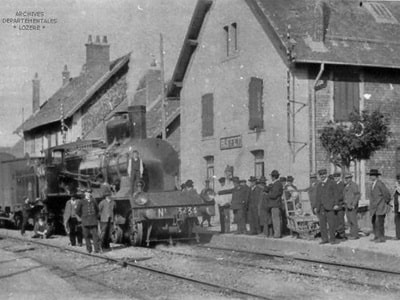 At the beginning of the 16th century, La Bastide was a hamlet of seven or eight houses located on the right bank of the Allier. In the Gevaudan region, there was a farm inhabited for several centuries by the Bastide family (which, for some, gave its name to the village) and which was also called "Trouillas." To the south of La Bastide stood a chapel named Saint-Thomas de la Souche: its location is now marked only by a rustic cross, opposite the current cemetery. The chapel was built to facilitate the religious practices of travelers who took the Regordane road.
At the beginning of the 16th century, La Bastide was a hamlet of seven or eight houses located on the right bank of the Allier. In the Gevaudan region, there was a farm inhabited for several centuries by the Bastide family (which, for some, gave its name to the village) and which was also called "Trouillas." To the south of La Bastide stood a chapel named Saint-Thomas de la Souche: its location is now marked only by a rustic cross, opposite the current cemetery. The chapel was built to facilitate the religious practices of travelers who took the Regordane road.
Near La Bastide, one could find in the valley of the Allier, the metairie des Huttes; and in the valley of the Trappe stream, a few farms or private houses. A farm-inn with the sign of La Grande-Halte served as a relay for travelers, pilgrims, merchants, and transhumants who followed the Regordane road.
The arrival of the railway in 1870, followed by the creation of the Notre-Dame-des-Neiges monastery a few years later, as well as the emergence of the thermal spa of Saint-Laurent-les-Bains, greatly contributed to the development of the village which, from a stopping place, became a small mountain tourist resort. The village was built from scratch over time, and its atypical history explains its current location: positioned between Occitanie and Auvergne-Rhône-Alpes, Lozere and Ardeche.
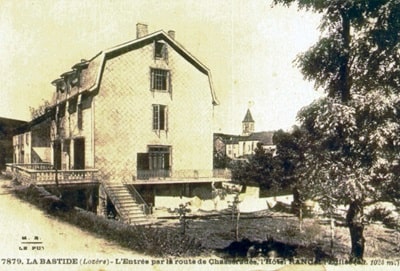 La Bastide 1,018 m.; SNCF railway, buses to Saint-Laurent-les-Bains (Ardeche); Hôtel des Pins, 30 rooms; Hôtel du Parc (currently Maison d'hôtes L'Etoile), 22 rooms; Terminus, at the station, 20 rooms, municipality of La Bastide-Puylaurent (1,289 inhabitants), a summer resort frequented by families from the South, is located on the nascent Allier, in a valley of meadows, near the bald and rounded peaks of the Cevennes ridge, which are very snowy in winter (beautiful ski fields now frequented). La Bastide, due to its altitude and location on the watershed, always enjoys great freshness in summer.
La Bastide 1,018 m.; SNCF railway, buses to Saint-Laurent-les-Bains (Ardeche); Hôtel des Pins, 30 rooms; Hôtel du Parc (currently Maison d'hôtes L'Etoile), 22 rooms; Terminus, at the station, 20 rooms, municipality of La Bastide-Puylaurent (1,289 inhabitants), a summer resort frequented by families from the South, is located on the nascent Allier, in a valley of meadows, near the bald and rounded peaks of the Cevennes ridge, which are very snowy in winter (beautiful ski fields now frequented). La Bastide, due to its altitude and location on the watershed, always enjoys great freshness in summer.
Excursions around La Bastide-Puylaurent:
1st Sources of the Allier (to the West; 4 h. 30 on foot). — One takes the train on the Mende line to the Chasserades station. From there, a path to the Northwest leads in 1 h. 15 to the sources of the Allier, at the foot of the wooded slopes of Mourre de la Gardille (1,501 m.) which can be climbed without difficulty in 45 min.: a beautiful view of Mont Lozere and the Causses. From there, one returns directly to La Bastide by following to the East a ridge at an altitude of 1,300 m.
2nd Palet du Thort (dolmen), 4 km to the South, via the ridges.
3rd Trappe de Notre-Dame-des-Neiges (road 3 km 5 East). A path branches off at 2 km 5, to the left of the road to Saint-Laurent-les-Bains and descends through a beautiful forest of pines, spruces, and beeches, to the Trappe de Notre-Dame-des-Neiges (1,110 m.) which was founded in 1850 on land from the former abbey of Chambons, in a solitary valley whose stream joins the Allier at La Bastide-Puylaurent; burned down in 1912, the monastery has been rebuilt.
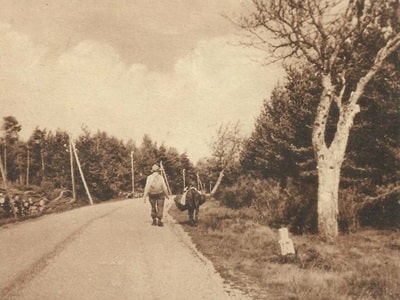 From the Trappe, one can walk (3 km) to Saint Laurent les Bains, by climbing a valley to the Northeast; one passes near the farm of Felgere; one reaches the col du Pal and descends to the East passing to the left of the old tower dominating Saint Laurent les Bains.
From the Trappe, one can walk (3 km) to Saint Laurent les Bains, by climbing a valley to the Northeast; one passes near the farm of Felgere; one reaches the col du Pal and descends to the East passing to the left of the old tower dominating Saint Laurent les Bains.
From La Bastide to Mende (railway, 48 km; road of 49 km West-Southwest, crossing the Montbel causse). One crosses the Allier and follows to the left the C. 6 road which rises up the upper valley of this river for about 7 km; then it crosses, with the railway, at an altitude of 1,175 m., a threshold that takes it from the upper valley of the Allier into that of the Chassezac.
Chasserades (1,150 m.), from where one can reach in 1 h. 15 the source of the Allier; Romanesque church with a defensive tower.
The road, rising up to Belvezet in the upper valley of the Chassezac, passes under the beautiful viaduct of Mirandol. — 12 km 5. To the left branches a small road that climbs through the woods to Montagne du Goulet (1,499 m.; 6 km 5 to the terminus of the road and 30 min. on foot). 16 km 5. One leaves to the right Saint-Frezal-d'Albuges which has a Romanesque church.
17 km 5. Belvezet (1,197 m.), a village located in the midst of cultivated valleys, near the sources of the Chassezac; an ascent in 1 h. 33 to Mourre de la Gardille (1,501 m.). The road rises on the causse. 22 km 5. Montbel (1,224 m.), 399 inhabitants, on the causse of the same name.
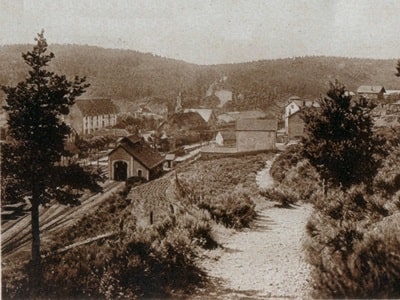 The causse of Montbel represents a point pushed by the Jurassic of the Causses amid the ancient rocks of Gevaudan. It is a causse at its first stage, where the waters have not yet carved their underground galleries and their canyons: there are, however, some avens. The causse of Montbel, "roof of France," plays a very important hydrographic role: the waters flow southeast towards the Chassezac and the Rhône, to the north towards the Allier and the Loire, and to the west towards the Lot, the Truyere, and the Garonne. This triple watershed is extended to the Northeast and Southeast by the Cevennes, to the Northwest by the plateau of Roi and the mountains of Margeride. This causse has a very harsh climate and its resources can only be pastoral: 50,000 sheep, transhumant from Languedoc through its "drailles," come to graze the fine, short, and dry grass of its plateaus.
The causse of Montbel represents a point pushed by the Jurassic of the Causses amid the ancient rocks of Gevaudan. It is a causse at its first stage, where the waters have not yet carved their underground galleries and their canyons: there are, however, some avens. The causse of Montbel, "roof of France," plays a very important hydrographic role: the waters flow southeast towards the Chassezac and the Rhône, to the north towards the Allier and the Loire, and to the west towards the Lot, the Truyere, and the Garonne. This triple watershed is extended to the Northeast and Southeast by the Cevennes, to the Northwest by the plateau of Roi and the mountains of Margeride. This causse has a very harsh climate and its resources can only be pastoral: 50,000 sheep, transhumant from Languedoc through its "drailles," come to graze the fine, short, and dry grass of its plateaus.
To the West of Montbel, the C. 6 road joins (27 km) the N. 88 road. 28 km Col de la Pierre Plantee (1,264 m.): from there to Mende, 22 km by the N. 88 road.
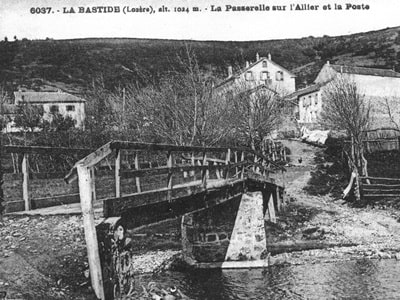 From La Bastide-Puylaurent to Les Vans (road 44 km Southeast, picturesque and rugged; bus service to Saint-Laurent). One leaves La Bastide by the N. 106 road, to the Southeast, and takes to the left, at 0 km 5, the D. 4 road which rises to the East on the desolate ridge of the Cevennes, overlooking the deep ravines of the Borne: magnificent view of the wooded ridges of chestnut trees and, in the distance, Mont Lozere.
From La Bastide-Puylaurent to Les Vans (road 44 km Southeast, picturesque and rugged; bus service to Saint-Laurent). One leaves La Bastide by the N. 106 road, to the Southeast, and takes to the left, at 0 km 5, the D. 4 road which rises to the East on the desolate ridge of the Cevennes, overlooking the deep ravines of the Borne: magnificent view of the wooded ridges of chestnut trees and, in the distance, Mont Lozere.
2 km 5. A statue of the Virgin marks the entrance to the path of the Trappe de Notre Dame des Neiges, to the left. The road continues to climb until a threshold of 1,150 m., from where it descends for 5 km by large loops into the deep valley of the Borne.
8 km Saint-Laurent-les-Bains (840 m.; buses to the station of La Bastide-Saint-Laurent, Grand Hôtel des Thermes, June-Oct., 100 rooms), 403 inhabitants, a thermal spa in the gorge of a small tributary of the Borne, at the bottom of a true chasm, 500 m. deep, opened under the crest of the Cevennes. The ruins of an ancient square tower crown a steep rock 110 m. above the valley. The thermal waters (53°C), sodium bicarbonated, are used against rheumatism in general: the Grande Source feeds a public fountain and the thermal establishment where a Roman pool remains.
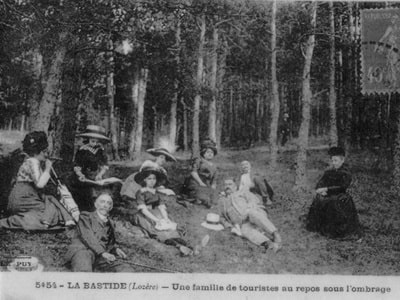 From Saint Laurent les Bains, one ascends Trepaloup (to the North; ascent 2 h., descent 1 h. 15): one reaches the ridge of the Cevennes by a mule path, to the West, then follows the ridge to the Northeast. From the summit of Trepaloup (1,408 m.), a very beautiful panorama: Mont Lozere, Mezenc, and on clear days, Ventoux. One will make a beautiful circuit returning via Borne and a very picturesque path following the edge of the upper gorges of the Borne (4 h. 30 in total).
From Saint Laurent les Bains, one ascends Trepaloup (to the North; ascent 2 h., descent 1 h. 15): one reaches the ridge of the Cevennes by a mule path, to the West, then follows the ridge to the Northeast. From the summit of Trepaloup (1,408 m.), a very beautiful panorama: Mont Lozere, Mezenc, and on clear days, Ventoux. One will make a beautiful circuit returning via Borne and a very picturesque path following the edge of the upper gorges of the Borne (4 h. 30 in total).
A very picturesque road, 17 km East, which makes a big detour to the South while following the edge of the gorges of the Liche-Chaude torrent, connects Saint-Laurent to Loubaresse, on the road from Puy-en-Velay to Largentieres.
From Saint Laurent les Bains, the D. 4 road continues to descend to cross the gorge of the Liche-Chaude torrent, then rises by a very steep climb through fir woods. It then descends for a long time, at a more moderate slope, on the side of the Chassezac, through a nearly deserted area.
29 km Peyre, a junction where one leaves the D. 4 road to follow the D. 10 road to the right which descends into the valley of the Chassezac.
42 km 5. One leaves to the left Chambonas, in a bend of the Chassezac dominated by a restored feudal castle, with a park attributed to Le Nôtre; Romanesque church containing a sculpted frieze. One crosses the Chassezac.
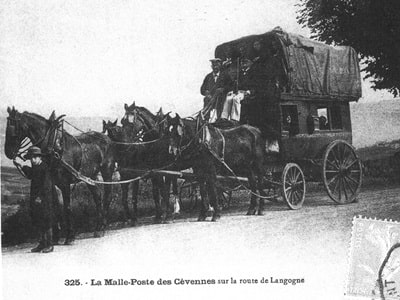 Beyond La Bastide, the N. 106 road, by a winding ascent, climbs a ridge from where one overlooks to the right the valley of the Allier which plunges to the West. Superb course. The road reaches 1,109 m. in altitude on the crest of the Cevennes: one passes from the Loire basin to that of the Rhône. Descent into the valley of the Chassezac, a tributary of the Ardeche, which is reached at Prevencheres (850 m.): 12th and 15th century church preceded by a magnificent lime tree; ruined castle. The road follows the meanders of the Chassezac and then runs along the cliffs above the gorges where the torrent plunges.
Beyond La Bastide, the N. 106 road, by a winding ascent, climbs a ridge from where one overlooks to the right the valley of the Allier which plunges to the West. Superb course. The road reaches 1,109 m. in altitude on the crest of the Cevennes: one passes from the Loire basin to that of the Rhône. Descent into the valley of the Chassezac, a tributary of the Ardeche, which is reached at Prevencheres (850 m.): 12th and 15th century church preceded by a magnificent lime tree; ruined castle. The road follows the meanders of the Chassezac and then runs along the cliffs above the gorges where the torrent plunges.
85 km La Garde-Guerin (875 m.), a very picturesque hamlet at the northern extremity and on the edge of the plateau that almost drops straight down on the right bank of the Chassezac: splendid view.
This was once the seat of a curious community of twenty-seven noble peers, founded by the bishops of Mende and tasked with escorting and protecting, for a toll, travelers on the GR®700 Voie Regordane, an ancient Gallic and Roman road that, starting from Nîmes, crossed the hill of Villefort, passed by the old hamlet of Bayard, climbed a steep ramp, and crossed the plateau known as Serre des Mulets; it served as a transhumance route towards Lozere and Aubrac and remained throughout the Middle Ages the only communication between Languedoc and Auvergne.
La Garde-Guerin retains the remains of the enclosure that surrounded its twenty-seven fortified houses and a large square tower from the ancient castle of the 10th and 11th centuries, standing 21 m. high; a small restored Romanesque church. The road, extremely picturesque, now descends while following along the edge of the curious plateau of La Garde-Guerin and overlooking the picturesque gorges of the Altier, then making a large detour to the North to regain the direction of the South at the bottom of a ravine. At the bottom of this descent, one emerges on the left bank of the Altier and leaves to the right the N. 101 road which passes under the beautiful viaduct of Bayard, with two levels of arcades, 72 m. high, where the Nîmes line passes. Turning left, one crosses the Altier on the Louis-Philippe bridge and passes through the Bayard tunnel, 200 m. long, into the valley of Palheres.
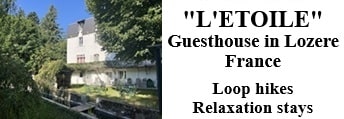
Former holiday hotel with a garden along the Allier, L'Etoile Guest House is located in La Bastide-Puylaurent between Lozere, Ardeche, and the Cevennes in the mountains of Southern France. At the crossroads of GR®7, GR®70 Stevenson Path, GR®72, GR®700 Regordane Way, GR®470 Allier River springs and gorges, GRP® Cevenol, Ardechoise Mountains, Margeride. Numerous loop trails for hiking and one-day biking excursions. Ideal for a relaxing and hiking getaway.
Copyright©etoile.fr

 At the beginning of the 16th century, La Bastide was a hamlet of seven or eight houses located on the right bank of the Allier. In the Gevaudan region, there was a farm inhabited for several centuries by the Bastide family (which, for some, gave its name to the village) and which was also called "Trouillas." To the south of La Bastide stood a chapel named Saint-Thomas de la Souche: its location is now marked only by a rustic cross, opposite the current cemetery. The chapel was built to facilitate the religious practices of travelers who took the Regordane road.
At the beginning of the 16th century, La Bastide was a hamlet of seven or eight houses located on the right bank of the Allier. In the Gevaudan region, there was a farm inhabited for several centuries by the Bastide family (which, for some, gave its name to the village) and which was also called "Trouillas." To the south of La Bastide stood a chapel named Saint-Thomas de la Souche: its location is now marked only by a rustic cross, opposite the current cemetery. The chapel was built to facilitate the religious practices of travelers who took the Regordane road. La Bastide 1,018 m.; SNCF railway, buses to Saint-Laurent-les-Bains (Ardeche); Hôtel des Pins, 30 rooms; Hôtel du Parc (currently Maison d'hôtes L'Etoile), 22 rooms; Terminus, at the station, 20 rooms, municipality of La Bastide-Puylaurent (1,289 inhabitants), a summer resort frequented by families from the South, is located on the nascent Allier, in a valley of meadows, near the bald and rounded peaks of the Cevennes ridge, which are very snowy in winter (beautiful ski fields now frequented). La Bastide, due to its altitude and location on the watershed, always enjoys great freshness in summer.
La Bastide 1,018 m.; SNCF railway, buses to Saint-Laurent-les-Bains (Ardeche); Hôtel des Pins, 30 rooms; Hôtel du Parc (currently Maison d'hôtes L'Etoile), 22 rooms; Terminus, at the station, 20 rooms, municipality of La Bastide-Puylaurent (1,289 inhabitants), a summer resort frequented by families from the South, is located on the nascent Allier, in a valley of meadows, near the bald and rounded peaks of the Cevennes ridge, which are very snowy in winter (beautiful ski fields now frequented). La Bastide, due to its altitude and location on the watershed, always enjoys great freshness in summer. From the Trappe, one can walk (3 km) to Saint Laurent les Bains, by climbing a valley to the Northeast; one passes near the farm of Felgere; one reaches the col du Pal and descends to the East passing to the left of the old tower dominating Saint Laurent les Bains.
From the Trappe, one can walk (3 km) to Saint Laurent les Bains, by climbing a valley to the Northeast; one passes near the farm of Felgere; one reaches the col du Pal and descends to the East passing to the left of the old tower dominating Saint Laurent les Bains. The causse of Montbel represents a point pushed by the Jurassic of the Causses amid the ancient rocks of Gevaudan. It is a causse at its first stage, where the waters have not yet carved their underground galleries and their canyons: there are, however, some avens. The causse of Montbel, "roof of France," plays a very important hydrographic role: the waters flow southeast towards the Chassezac and the Rhône, to the north towards the Allier and the Loire, and to the west towards the Lot, the Truyere, and the Garonne. This triple watershed is extended to the Northeast and Southeast by the Cevennes, to the Northwest by the plateau of Roi and the mountains of Margeride. This causse has a very harsh climate and its resources can only be pastoral: 50,000 sheep, transhumant from Languedoc through its "drailles," come to graze the fine, short, and dry grass of its plateaus.
The causse of Montbel represents a point pushed by the Jurassic of the Causses amid the ancient rocks of Gevaudan. It is a causse at its first stage, where the waters have not yet carved their underground galleries and their canyons: there are, however, some avens. The causse of Montbel, "roof of France," plays a very important hydrographic role: the waters flow southeast towards the Chassezac and the Rhône, to the north towards the Allier and the Loire, and to the west towards the Lot, the Truyere, and the Garonne. This triple watershed is extended to the Northeast and Southeast by the Cevennes, to the Northwest by the plateau of Roi and the mountains of Margeride. This causse has a very harsh climate and its resources can only be pastoral: 50,000 sheep, transhumant from Languedoc through its "drailles," come to graze the fine, short, and dry grass of its plateaus. From La Bastide-Puylaurent to Les Vans (road 44 km Southeast, picturesque and rugged; bus service to Saint-Laurent). One leaves La Bastide by the N. 106 road, to the Southeast, and takes to the left, at 0 km 5, the D. 4 road which rises to the East on the desolate ridge of the Cevennes, overlooking the deep ravines of the Borne: magnificent view of the wooded ridges of chestnut trees and, in the distance, Mont Lozere.
From La Bastide-Puylaurent to Les Vans (road 44 km Southeast, picturesque and rugged; bus service to Saint-Laurent). One leaves La Bastide by the N. 106 road, to the Southeast, and takes to the left, at 0 km 5, the D. 4 road which rises to the East on the desolate ridge of the Cevennes, overlooking the deep ravines of the Borne: magnificent view of the wooded ridges of chestnut trees and, in the distance, Mont Lozere. From Saint Laurent les Bains, one ascends Trepaloup (to the North; ascent 2 h., descent 1 h. 15): one reaches the ridge of the Cevennes by a mule path, to the West, then follows the ridge to the Northeast. From the summit of Trepaloup (1,408 m.), a very beautiful panorama: Mont Lozere, Mezenc, and on clear days, Ventoux. One will make a beautiful circuit returning via Borne and a very picturesque path following the edge of the upper gorges of the Borne (4 h. 30 in total).
From Saint Laurent les Bains, one ascends Trepaloup (to the North; ascent 2 h., descent 1 h. 15): one reaches the ridge of the Cevennes by a mule path, to the West, then follows the ridge to the Northeast. From the summit of Trepaloup (1,408 m.), a very beautiful panorama: Mont Lozere, Mezenc, and on clear days, Ventoux. One will make a beautiful circuit returning via Borne and a very picturesque path following the edge of the upper gorges of the Borne (4 h. 30 in total). Beyond La Bastide, the N. 106 road, by a winding ascent, climbs a ridge from where one overlooks to the right the valley of the Allier which plunges to the West. Superb course. The road reaches 1,109 m. in altitude on the crest of the Cevennes: one passes from the Loire basin to that of the Rhône. Descent into the valley of the Chassezac, a tributary of the Ardeche, which is reached at Prevencheres (850 m.): 12th and 15th century church preceded by a magnificent lime tree; ruined castle. The road follows the meanders of the Chassezac and then runs along the cliffs above the gorges where the torrent plunges.
Beyond La Bastide, the N. 106 road, by a winding ascent, climbs a ridge from where one overlooks to the right the valley of the Allier which plunges to the West. Superb course. The road reaches 1,109 m. in altitude on the crest of the Cevennes: one passes from the Loire basin to that of the Rhône. Descent into the valley of the Chassezac, a tributary of the Ardeche, which is reached at Prevencheres (850 m.): 12th and 15th century church preceded by a magnificent lime tree; ruined castle. The road follows the meanders of the Chassezac and then runs along the cliffs above the gorges where the torrent plunges.